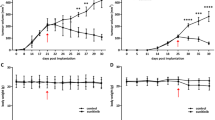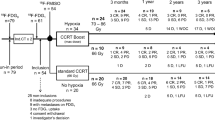Abstract
Purpose
The hypoxic microenvironments of solid tumours are complex and reduce the susceptibility of cancer cells to chemo- and radiotherapy. Conventional radiosensitisers have poor specificity, unsatisfactory therapeutic effects, and significant side effects. Anaerobic bacteria colonise and destroy hypoxic areas of the tumour and consequently enhance the effects of radiation.
Methods
In this study, we treated a Lewis lung carcinoma transplant mouse model with Bifidobacterium infantis (Bi) combined with its specific monoclonal antibody (mAb) and radiotherapy (RT) to investigate its ability to radiosensitise the tumour. The tumour metabolism and hypoxia in the tumour tissue were monitored by micro-18F-FDG and 18F-FMISO PET/CT imaging. Immunohistochemistry was used to detect phosphorylated histone (γ-H2AX), proliferation (Ki-67), platelet endothelial cell adhesion molecules (CD31), tumour necrosis factor-α (TNF-α), hypoxia-inducible factor-1α (HIF-1α), and glucose transporter 1 (Glut-1) levels.
Results
Tumour growth was slowed and survival time was markedly prolonged in mice subjected to the combination of B. infantis, specific antibody, and radiotherapy. Levels of HIF-1α, Glut-1, Ki-67, and CD31 expression, as well as uptake of FDG and FMISO, were the lowest in the combination-treated mice. In contrast, γ-H2AX and TNF-α expression levels were elevated and hypoxia in tumour tissue was reduced compared with controls.
Conclusion
In conclusion, our data indicated that the curative effect of radiotherapy for lung cancer was enhanced by pre-treating mice with a combination of B. infantis and its specific monoclonal antibody.








Similar content being viewed by others
Code availability
Not applicable.
Abbreviations
- Bi:
-
Bifidobacterium infantis
- mMAb:
-
Monoclonal antibody
- RT:
-
Radiotherapy
- γ-H2AX:
-
Phosphorylated histone
- Ki-67:
-
The proliferation index
- CD31:
-
Platelet endothelial cell adhesion molecules
- TNF-α:
-
Tumor necrosis factor-α
- HIF-1α:
-
Hypoxia inducible factor-1α
- Glut-1:
-
Glucose transporter 1
- PBS:
-
Phosphate-buffered saline
- CFU:
-
Colony forming units
- H&E:
-
Haematoxylin and eosin staining
- MVD:
-
Microvessel density
References
Bettegowda C, Dang LH et al (2003) Overcoming the hypoxic barrier to radiation therapy with anaerobic bacteria. Proc Natl Acad Sci U S A 100(25):15083–15088. https://doi.org/10.1073/pnas.2036598100
Bray F, Ferlay J, Soerjomataram I, Siegel RL, Torre LA, Jemal A (2018) Global cancer statistics 2018: GLOBOCAN estimates of incidence and mortality worldwide for 36 cancers in 185 countries. CA Cancer J Clin 68(394–68):424. https://doi.org/10.3322/caac.21492
Bristow RG, Hill RP (2008) Hypoxia and metabolism hypoxia, DNA repair and genetic instability. Nat Rev Cancer 8(3):180–192. https://doi.org/10.1038/nrc2344
Brown JM, Wilson WR (2004) Exploiting tumour hypoxia in cancer treatment. Nat Rev Cancer 4(6):437–447. https://doi.org/10.1038/nrc1367
Carmeliet P, Jain RK (2000) Angiogenesis in cancer and other diseases. Nature 407(6801):249–257. https://doi.org/10.1038/35025220
Chmura SJ, Gupta N, Advani SJ, Kufe DW, Weichselbaum RR (2001) Prospects for viral-based strategies enhancing the anti-tumor effects of ionizing radiation. Semin Radiat Oncol 11(338–11):345. https://doi.org/10.1053/srao.2001.26019
Crino L, Weder W, van Meerbeeck J, Felip E, Group EGW (2010) Early stage and locally advanced (non-metastatic) non-small-cell lung cancer: ESMO Clinical Practice Guidelines for diagnosis, treatment and follow-up. Ann Oncol 21(Suppl 5):v103–v115. https://doi.org/10.1093/annonc/mdq207
Dang LH, Bettegowda C, Huso DL, Kinzler KW, Vogelstein B (2001) Combination bacteriolytic therapy for the treatment of experimental tumors. Proc Natl Acad Sci USA 98(26):15155–15160. https://doi.org/10.1073/pnas.251543698
Dueñas-Gonzalez A, Cetina L, Mariscal I, Garza J (2003) Modern management of locally advanced cervical carcinoma. Cancer Treat Rev 29(5):389–399. https://doi.org/10.1016/s0305-7372(03)00068-9
Garcia-Barros M, Paris F, Cordon-Cardo C, Lyden D, Rafii S, Haimovitz-Friedman A, Fuks Z, Kolesnick R (2003) Tumor response to radiotherapy regulated by endothelial cell apoptosis. Science 300(5622):1155–1159. https://doi.org/10.1126/science.1082504
Glatzel-Plucinska N, Piotrowska A, Grzegrzolka J, Olbromski M, Rzechonek A, Dziegiel P, Podhorska-Okolow M (2018) SATB1 level correlates with Ki-67 expression and is a positive prognostic factor in non-small cell lung carcinoma. Anticancer Res 38(2):723–736. https://doi.org/10.21873/anticanres.12278
Harrison LB, Chadha M, Hill RJ, Hu K, Shasha D (2004) Impact of tumor hypoxia and anemia on radiation therapy outcomes. Oncologist 7(6):492–508. https://doi.org/10.1016/j.ijrobp.2008.04.052
Havell EA, Fiers W, North RJ (1988) The antitumor function of tumor necrosis factor (TNF), I. Therapeutic action of TNF against an established murine sarcoma is indirect, immunologically dependent, and limited by severe toxicity. J Exp Med 167(3):1067–1085. https://doi.org/10.1084/jem.167.3.1067
Helmlinger G, Yuan F, Dellian M, Jain RK (1997) Interstitial pH and pO2 gradients in solid tumors in vivo: high-resolution measurements reveal a lack of correlation. Nat Med 3(2):177–182. https://doi.org/10.1038/nm0297-177
Hockel M, Schlenger K, Aral B, Mitze M, Schaffer U, Vaupel P (1996) Association between tumor hypoxia and malignant progression in advanced cancer of the uterine cervix. Cancer Res 56(19):4509–4515
Hung MS, Wu YF, Chen YC (2019) Efficacy of chemoradiotherapy versus radiation alone in patients with inoperable locally advanced non-small-cell lung cancer: a meta-analysis and systematic review. Medicine (Baltimore) 98:e16167. https://doi.org/10.1097/MD.0000000000016167
Jiang Y, Allen D, Kersemans V, Devery AM, Bokobza SM, Smart S, Ryan AJ (2015) Acute vascular response to cediranib treatment in human non-small-cell lung cancer xenografts with different tumour stromal architecture. Lung Cancer 90(2):191–198. https://doi.org/10.1016/j.lungcan.2015.08.009
Koh WJ, Rasey JS, Evans ML, Grierson JR, Lewellen TK, Graham MM, Krohn KA, Griffin TW et al (1992) Imaging of hypoxia in human tumors with [F-18]fluoromisonidazole. Int J Radiat Oncol Biol Phys 22(1):199–212. https://doi.org/10.1016/0360-3016(92)91001-4
Kubota K, Tada M, Yamada S, Hori K, Saito S, Iwata R, Sato K, Fukuda H et al (1999) Comparison of the distribution of fluorine-18 fluoromisonidazole, deoxyglucose and methionine in tumour tissue. Eur J Nucl Med 26(7):750–757. https://doi.org/10.1007/s002590050446
Luo CH, Huang CT, Su CH, Yeh CS (2016) Bacteria-mediated hypoxia-specific delivery of nanoparticles for tumors imaging and therapy. Nano Lett 16(6):3493–3499. https://doi.org/10.1021/acs.nanolett.6b00262
Van MAbbeele AD (2008) The lessons of GIST–PET and PET/CT: a new paradigm for imaging. Oncologist 13(Suppl 2):8–13. https://doi.org/10.1634/theoncologist.13-S2-8
Machtay M, Paulus R, Moughan J, Komaki R, Bradley JE, Choy H, Albain K, Movsas B, Sause WT, Curran WJ (2012) Defining local-regional control and its importance in locally advanced non-small cell lung carcinoma. J Thorac Oncol 7(716–7):722. https://doi.org/10.1097/JTO.0b013e3182429682
Mah LJ, El-Osta A, Karagiannis TC (2010) gammaH2AX: a sensitive molecular marker of DNA damage and repair. Leukemia 24(4):679–686. https://doi.org/10.1038/leu.2010.6
McGinn CJ, Lawrence TS (2001) Recent advances in the use of radiosensitizing nucleosides. Semin Radiat Oncol 11(270–11):280. https://doi.org/10.1053/srao.2001.26002
Melillo G (2007) Targeting hypoxia cell signaling for cancer therapy. Cancer Metastasis Rev 26(2):341–352. https://doi.org/10.1007/s10555-007-9059-x
Ni XL, Chen LX, Zhang H, Yang B, Xu S, Wu M, Liu J, Yang LL et al (2017) In vitro and in vivo antitumor effect of gefitinib nanoparticles on human lung cancer. Drug Deliv 24(1):1501–1512. https://doi.org/10.1080/10717544.2017.1384862
Phase I/II study (2014) APS001F with flucytosine and maltose in solid tumors (ClinicalTrials.gov Identifier: NCT01562626, last verified. https://clinicaltrials.gov/ct2/show/NCT01562626).
Provencio M, Sanchez A, Garrido P, Valcarcel F (2010) New molecular targeted therapies integrated with radiation therapy in lung cancer. Clin Lung Cancer 11(91–11):97. https://doi.org/10.3816/CLC.2010.n.012
Ranjan AP, Mukerjee A, Gdowski A, Helson L, Bouchard A, Majeed M, Vishwanatha JK (2016) Curcumin-ER prolonged subcutaneous delivery for the treatment of non-small cell lung cancer. J Biomed Nanotechnol 12(4):679–688. https://doi.org/10.1166/jbn.2016.2207
Rasey JS, Casciari JJ, Hofstrand PD, Muzi M, Graham MM, Chin LK (2000) Determining hypoxic fraction in a rat glioma by uptake of radiolabeled fluoromisonidazole. Radiat Res 153(1):84–92. https://doi.org/10.1667/0033-7587(2000)153[0084:dhfiar]2.0.co;2
Roberts NJ, Zhang L, Janku F, Collins A, Bai RY, Staedtke V, Rusk AW, Tung D et al (2014) Intratumoral injection of Clostridium novyi-NT spores induces antitumor responses. Sci Transl Med 6(249):249
Rüegg C, Yilmaz A, Bieler G, Bamat J, Chaubert P, Lejeune FJ (1998) Evidence for the involvement of endothelial cell integrin alphaVbeta3 in the disruption of the tumor vasculature induced by TNF and IFN-gamma. Nat Med 4(4):408–414. https://doi.org/10.1038/nm0498-408
Semenza GL (2003) Targeting HIF-1 for cancer therapy. Nat Rev Cancer 3(10):721–732. https://doi.org/10.1038/nrc1187
Sun CJ, Yang ZG, Zhou XP, Zhou QH, Sun JT, Zhang SF, Li J, Yu JM et al (2007) Non-small cell lung cancer evaluated by first pass dynamic contrast-enhanced 16-slice spiral CT: correlation of tumor vascularity with pathological characteristics. Zhonghua Zhong Liu Za Zhi 29(6):429–433
Sznol M, Lin SL, Bermudes D, Zheng LM, King I (2000) Use of preferentially replicating bacteria for the treatment of cancer. J Clin Invest 105(8):1027–1030. https://doi.org/10.1172/JCI9818
Teicher BA (1995) Physiologic mechanisms of therapeutic resistance. Blood flow and hypoxia. Hematol Oncol Clin North Am 9(2):475–506. https://doi.org/10.1016/s0889-8588(18)30105-9
Valk PE, Mathis CA, Prados MD, Gilbert JC, Budinger TF (1992) Hypoxia in human gliomas: demonstration by PET with fluorine-18-fluoromisonidazole. J Nucl Med 33(12):2133–2137
Vaupel P (2008) Hypoxia and aggressive tumor phenotype: implications for therapy and prognosis. Oncologist 13(Suppl 3):21–26. https://doi.org/10.1634/theoncologist.13-S3-21
Wachsberger P, Burd R, Dicker AP (2003) Tumor response to ionizing radiation combined with antiangiogenesis or vascular targeting agents: exploring mechanisms of interaction. Clin Cancer Res 91(957–91):971
Xia Y, Choi HK, Lee K (2012) Recent advances in hypoxia-inducible factor (HIF)-1 inhibitors. Eur J Med Chem 4(924–4):940. https://doi.org/10.1016/j.ejmech.2012.01.033
Xie F, Ding RL, He WF, Liu ZJ, Fu SZ, Wu JB, Yang LL, Lin S et al (2017) In vivo antitumor effect of endostatin-loaded chitosan nanoparticles combined with paclitaxel on Lewis lung carcinoma. Drug Deliv 24(1):1410–1418. https://doi.org/10.1080/10717544.2017.1378938
Xu XD, Shao SX, Jiang HP, Cao YW, Wang YH, Yang XC, Niu HT (2015) Warburg effect or reverse warburg effect? A review of cancer metabolism. Oncol Res Treat 38(3):117–122. https://doi.org/10.1159/000375435
Yang H, Zhong JT, Zhou SH, Han HM (2019) Roles of GLUT-1 and HK-II expression in the biological behavior of head and neck cancer. Oncotarget 10(32):3066–3083. https://doi.org/10.18632/oncotarget.24684
Yazawa K, Fujimori M, Nakamura T, Sasaki T, Amano J, Kano Y, Taniguchi S (2001) Bifidobacterium longum as a delivery system for gene therapy of chemically induced rat mammary tumors. Breast Cancer Res Treat 66(2):165–170. https://doi.org/10.1023/a:1010644217648
Yi C, Huang Y, Guo ZY, Wang SR (2005) Antitumor effect of cytosine deaminase/5-fluorocytosine suicide gene therapy system mediated by Bifidobacterium infantis on melanoma. Acta Pharmacol Sin 26(5):629–634. https://doi.org/10.1111/j.1745-7254.2005.00094.x
Yu Y, Xu S, You H, Zhang Y, Yang B, Sun X, Yang L, Chen Y et al (2017) In vivo synergistic anti-tumor effect of paclitaxel nanoparticles combined with radiotherapy on human cervical carcinoma. Drug Deliv 24(1):75–82. https://doi.org/10.1080/10717544.2016.1230902
Acknowledgements
The authors would like to thank all the reviewers who participated in the review and MJEditor (www.mjeditor.com) for its linguistic assistance during the preparation of this manuscript. We thank the Animal Experimental Center of the Southwest Medical University (Luzhou, China) for their great technical assistance. We thank YuC (Nuclear Medicine Research Center of the Affiliated hospital of Southwest Medical University, China) for his/her help in the acquisition of PET/CT images from animals and we greatly appreciate the contribution of the Pathology Laboratory of the Affiliated hospital of Southwest Medical University in performing immunohistochemistry staining.
Funding
This study was funded by the project from Health and Family Planning Commission of Sichuan Province (No. 17PJ557), the research project from Office of Science & Technology and Intellectual Property of Luzhou (No. 2017), the Union Project of Luzhou and Southwest Medical University under Grant (No.14JC0144 and 2013LZLY-J40) and the open subject of Nuclear Medicine and Molecular Imaging Key Laboratory of Sichuan Province (No. 2019.282).
Author information
Authors and Affiliations
Contributions
All authors contributed to the study conception and design. Material preparation, data collection and analysis were performed by JY, ZW and YC. CH and DL performed the experiments. The whole experiment was completed under the guidance of JW, SF, QW, YC. The first draft of the manuscript was written by JY and SI. All authors commented on previous versions of the manuscript and approved the final manuscript.
Corresponding authors
Ethics declarations
Conflict of interest
The authors declare that they have no conflict of interest.
Ethical approval
This study was approved by the Affiliated hospital of Southwest Medical University. All animal studies were approved by Central Laboratory of Affiliated Hospital of Southwest Medical University.
Consent to participate
Not applicable.
Consent for publication
All authors approved of the manuscript and consented to its publication.
Availability of data and material
All data are included in the manuscript.
Additional information
Publisher's Note
Springer Nature remains neutral with regard to jurisdictional claims in published maps and institutional affiliations.
Rights and permissions
About this article
Cite this article
Yang, J., Wu, Z., Chen, Y. et al. Pre-treatment with Bifidobacterium infantis and its specific antibodies enhance targeted radiosensitization in a murine model for lung cancer. J Cancer Res Clin Oncol 147, 411–422 (2021). https://doi.org/10.1007/s00432-020-03434-0
Received:
Accepted:
Published:
Issue Date:
DOI: https://doi.org/10.1007/s00432-020-03434-0




